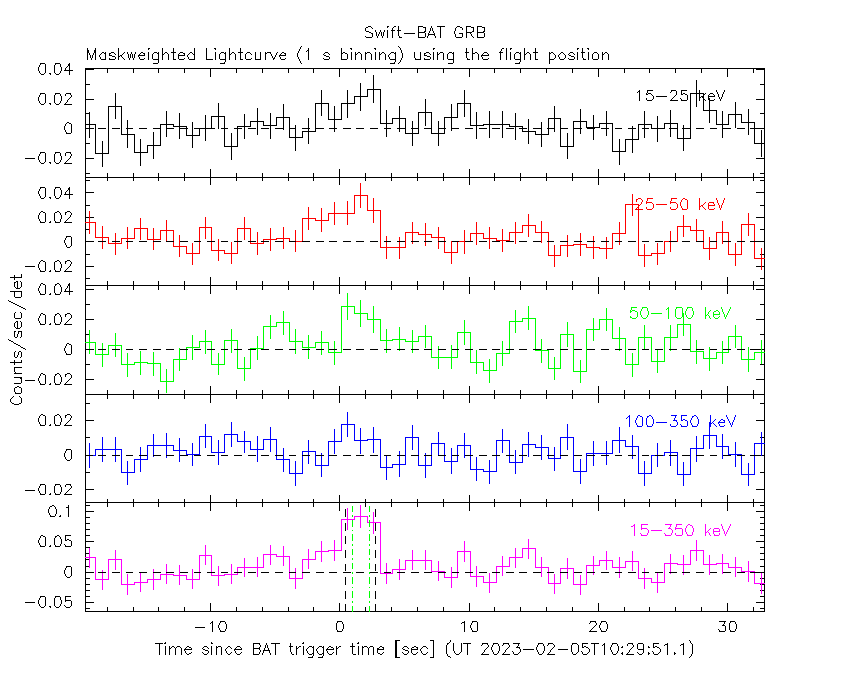
E. Ambrosi (INAF-IASFPA), K.L. Page (U. Leicester) and M.H. Siegel (PSU) for the Swift team
At 10:29:51 UT, the Swift Burst Alert Telescope (BAT) triggered and located GRB 230205A (trigger=1152764) (Ambrosi et al. GCN Circ. 33271). Swift slewed immediately to the burst. At the time of the trigger, the initial BAT position was 120° from the Sun (7.8 hours West) and 58° from the 100%-illuminated Moon. Table 1 contains the best reported positions from Swift, and the latest XRT position can be viewed at http://www.swift.ac.uk/xrt_positions.
Table 2 is a summary of GCN Circulars about this GRB from observatories other than Swift.
Standard analysis products for this burst are available at https://gcn.gsfc.nasa.gov/swift_gnd_ana.html.
As reported by Sakamoto et al. (GCN Circ. 33280),
the BAT ground-calculated position is RA, Dec = 202.057, 46.686 deg which is RA(J2000) = 1
The mask-weighted light curve (Figure 1) shows a short pulse that starts at ~
The time-averaged spectrum from T+0.32 to T+2.87 s is best fit by a simple power-law model.
The power law index of the time-averaged spectrum is 1.44 ± 0.29.
The fluence in the 15-150 keV band is 1.6 ± 0.3 x 1
The results of the batgrbproduct analysis are available at https://gcn.gsfc.nasa.gov/notices_s/1152764/BA/.
Analysis of the initial XRT data was reported by Page et al. (GCN Circ. 33277).
We have analysed 22 ks of XRT data for GRB 230205A, from 80 s to 275.1 ks after the BAT trigger. The data comprise 10 s in Windowed Timing (WT) mode (taken while Swift was slewing), with the remainder in Photon Counting (PC) mode. The enhanced XRT position for this burst was given by Goad et al. (GCN Circ. 33275).
The late-time light curve (Figure 2) (from T0+5.1 ks) can be modelled with a power-law decay with a decay index of α=0.91 (+0.14, -0.13).
A spectrum formed from the PC mode data can be fitted with an absorbed power-law with a photon spectral index of 1.89 (+0.22, -0.21). The best-fitting absorption column is 6.1 (+1.6, -1.4) x 1
A summary of the PC-mode spectrum is thus:
Total column: 6.1 (+1.6, -1.4) x 1
Galactic foreground: 2.1 x 1
Excess significance: 7.0 σ
Photon index: 1.89 (+0.22, -0.21)
The results of the XRT team automatic analysis are available at http://www.swift.ac.uk/xrt_products/01152764.
The Swift/UVOT began settled observations of the field of GRB 230205A 100 s after the BAT trigger
(Siegel and Ambrosi GCN Circ. 33289).
No optical afterglow consistent with the XRT position (Goad et al. GCN Circ. 33275) is detected in the initial UVOT exposures.
Table 3 gives preliminary
magnitudes using the UVOT photometric system
(Breeveld et al. 2011, AIP Conf. Proc., 1358, 373).
No correction has been made for the expected extinction in the Milky Way
corresponding to a reddening of

Figure 1. The BAT
mask-weighted light curve in the four individual and total
energy bands. The units are counts

Figure 2. The XRT light curve.
Any data from a crosshatched region are not included in the fit.
| RA (J2000) | Dec (J2000) | Error | Note | Reference |
|---|---|---|---|---|
| 1 |
+46°43'31.1" | 1.9" | XRT-final | UKSSDC |
| 1 |
+46°43'30.7" | 1.9" | XRT-enhanced | Goad et al. GCN Circ. 33275 |
| 1 |
+46°41'08.1" | 2.3' | BAT-refined | Sakamoto et al. GCN Circ. 33280 |
| Band | Authors | GCN Circ. | Subject | Observatory | Notes |
|---|---|---|---|---|---|
| Optical | Hu et al. | 33274 | BOOTES-5/JGT early optical upper limit | BOOTES | upper limits |
| Optical | Turpin et al. | 33282 | OHP/T193 optical observations | Obs.de Haute-Provence | |
| Optical | Wu et al. | 33283 | SVOM/C-GFT optical upper limit | C-GFT | upper limits |
| Optical | Strausbaugh and Cucchiara | 33286 | LCOGT Optical Upper Limits | Las Cumbres Obs. Global Tele.Network | upper limits |
| Optical | Urata | 33307 | SUBARU HSC pre-imaging for host galaxy search |
SUBARU | |
| Optical | O'Connor et al. | 33334 | Lowell Discovery Telescope Observations | Lowell Discovery Telescope | |
| Radio | Schroeder et al. | 33309 | 6 GHz VLA observations | VLA | |
| Radio | Schroeder and Laskar | 33372 | VLA radio afterglow confirmation | VLA | detection |
| Filter | Exp(s) | Mag | ||
|---|---|---|---|---|
| whit |
100 | 250 | 147 | >21.3 |
| 258 | 508 | 246 | >20.3 | |
| white | 100 | 5198 | 526 | >21.5 |
| v | 588 | 1581 | 117 | >19.5 |
| b | 514 | 1680 | 117 | >20.1 |
| u | 258 | 1481 | 343 | >20.2 |
| w1 | 638 | 657 | 19 | >19.2 |
Table 3. UVOT observations reported by Siegel and Ambrosi (GCN Circ. 33289). The start and stop times of the exposures are given in seconds since the BAT trigger. The preliminary 3-σ upper limits are given. No correction has been made for extinction in the Milky Way.
September 9, 2023